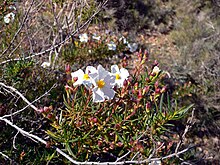Cistus clusii
| Cistus clusii | |
|---|---|
 |
|
| Scientific classification | |
| Kingdom: | Plantae |
| Clade: | Angiosperms |
| Clade: | Eudicots |
| Clade: | Rosids |
| Order: | Malvales |
| Family: | Cistaceae |
| Genus: | Cistus |
| Species: | C. clusii |
| Binomial name | |
|
Cistus clusii Dunal |
|
| Synonyms | |
|
|
Cistus clusii is a shrubby species of flowering plant in the family Cistaceae, with white flowers, native to south west and south central Europe and north Africa. It has been wrongly called Cistus libanotis by many authors.
Cistus clusii is a much branched shrub, up to 1 m (3 ft) tall. Its leaves are narrowly linear in shape, usually 1–2.5 cm (0.4–1.0 in) long by 1–2 mm (0.04–0.08 in) wide, with edges that are turned under (revolute), green on the upper side and densely covered with short hairs on the lower side, producing a whitish appearance. The flowers are arranged in an umbel-like cymes with up to 12 individual flowers, each 2–3 cm (0.8–1.2 in) across with five white petals and three sepals, 5–8 mm (0.2–0.3 in) long. The flower stalks (peduncles and pedicels) and the sepals are covered with long white hairs. The style is short.
Cistus clusii was first described by Michel Félix Dunal in 1824. The specific epithet clusii honours Carolus Clusius. The name Cistus libanotis has been wrongly applied to this species by many authors. A 2011 molecular phylogenetic study placed C. clusii in a clade with Cistus munbyi in the white and whitish pink clade of Cistus species, sister to all the remaining white and whitish pink flowered species.
Cistus clusii is native to north Africa and the west and central Mediterranean region: southern Spain, the Balearic Islands, south-east Italy and Sicily.
...
Wikipedia
